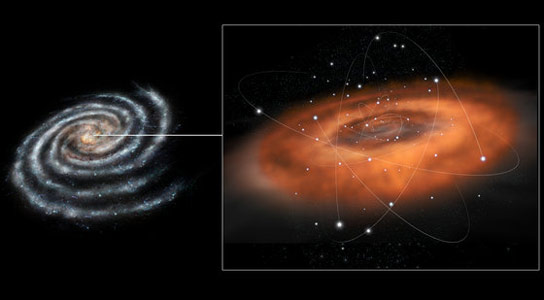
The Galactic Center hosts a supermassive black hole in the region known as Sagittarius A*, or Sgr A*, with a mass of about four million times that of our Sun. A dense torus of molecular gas and dust surrounds the Galactic Center and occupies the innermost 15 light-years of our Galaxy. Enshrouded within the disc is a central cavity, with a radius of a few light-years, filled with warm dust and lower-density gas. Part of this gas is being heated by the strong ultraviolet radiation from massive stars that closely orbit the central black hole. Heating also likely results from strong shocks, generated as gas orbits around or flows towards Sgr A*, in collisions between gas clouds or in material flowing at high velocity from stars and protostars. Credit: ESA–C. Carreau
Using ESA’s Herschel Space Observatory, scientists have detected and analyzed a variety of simple molecules at the center of Milky Way, allowing them to probe some of the fundamental properties of the interstellar gas surrounding the black hole at the center of the Milky Way galaxy.
ESA’s Herschel space observatory has made detailed observations of surprisingly hot molecular gas that may be orbiting or falling towards the supermassive black hole lurking at the center of our Milky Way galaxy.
Our local black hole is located in a region known as Sagittarius A* – Sgr A* – after a nearby radio source. It has a mass about four million times that of our Sun and lies around 26,000 light-years away from the Solar System.
Even at that distance, it is a few hundred times closer to us than any other galaxy with an active black hole at its center, making it the ideal natural laboratory to study the environment around these enigmatic objects.
Vast amounts of dust lie in the plane of the Milky Way between here and its center, obscuring our view at visible wavelengths. But at far-infrared wavelengths, it is possible to peer through the dust, affording Herschel’s scientists the chance to study the turbulent innermost region of our Galaxy in great detail.
Herschel has detected a great variety of simple molecules at the Milky Way’s heart, including carbon monoxide, water vapor, and hydrogen cyanide. By analyzing the signature from these molecules, astronomers have been able to probe some of the fundamental properties of the interstellar gas surrounding the black hole.
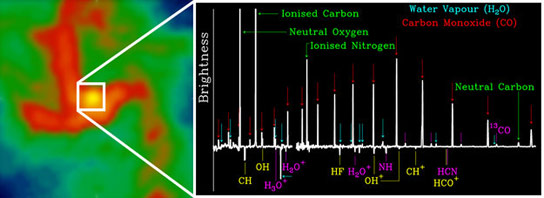
This illustration combines a view obtained at radio wavelengths of ionized gas at the center of our Galaxy, the Milky Way (left panel), with a spectrum towards the very center taken with ESA’s Herschel at far-infrared wavelengths (right panel).
The spectrum shows the rich variety of molecules that have been detected in this region, which range from carbon monoxide and water vapor to hydrogen cyanide and many light molecules that play a critical role in the chemistry of the interstellar medium. Some of them have been detected for the first time with Herschel.
These data show that the molecular gas is surprisingly hot – the temperature estimated from the emission from carbon monoxide reaches up to 1000 ºC. The most likely source of heating of the hot molecular gas are shocks that develop as gas orbits around or flows towards Sagittarius A*, the region hosting the supermassive black hole that lies at the center of the Milky Way. Credit: Radio-wavelength image: National Radio Astronomy Observatory/Very Large Array (courtesy of C. Lang); spectrum: ESA/Herschel/PACS & SPIRE/J.R. Goicoechea et al. (2013)
“Herschel has resolved the far-infrared emission within just 1 light-year of the black hole, making it possible for the first time at these wavelengths to separate emission due to the central cavity from that of the surrounding dense molecular disc,” says Javier Goicoechea of the Centro de Astrobiología, Spain, and lead author of the paper reporting the results.
The biggest surprise was quite how hot the molecular gas in the innermost central region of the Galaxy gets. At least some of it is around 1,000ºC (1,800ºF), much hotter than typical interstellar clouds, which are usually only a few tens of degrees above the –273ºC (-459ºF) of absolute zero.
While some of the heating is down to the fierce ultraviolet radiation pouring from a cluster of massive stars that live very close to the Galactic Center, they are not enough to explain the high temperatures alone.
In addition to the stellar radiation, Dr. Goicoechea’s team hypothesizes that emission from strong shocks in highly-magnetized gas in the region may be a significant contributor to the high temperatures. Such shocks can be generated in collisions between gas clouds, or in material flowing at high speed from stars and protostars.
“The observations are also consistent with streamers of hot gas speeding towards Sgr A*, falling towards the very center of the Galaxy,” says Dr. Goicoechea. “Our Galaxy’s black hole may be cooking its dinner right in front of Herschel’s eyes.”
Just before material falls into a black hole, it is heated up enormously and can cause high-energy X-ray and gamma-ray flares. While Sgr A* currently shows little sign of such activity, this could change soon.
Using near-infrared observations, other astronomers have spotted a separate, compact cloud of gas amounting to just a few Earth masses spiraling toward the black hole. Located much closer to the black hole than the reservoir of material studied by Herschel in this work, it may finally be gobbled up later this year.
Spacecraft including ESA’s XMM-Newton and Integral will be waiting to spot any high-energy burps as the black hole enjoys its feast.
“The center of the Milky Way is a complex region, but with these Herschel observations, we have taken an important step forward in our understanding of the vicinity of a supermassive black hole, which will ultimately help improve our picture of galaxy evolution,” says Göran Pilbratt, ESA’s Herschel project scientist.
Reference: “Far-Infrared Spectroscopy of the Galactic Center. Hot Molecular Gas: Shocks versus Radiation near SgrA*” by Javier R. Goicoechea, M. Etxaluze, J. Cernicharo, M. Gerin, D. A. Neufeld, A. Contursi, T. A. Bell, M. De Luca, P. Encrenaz, N. Indriolo, D. C. Lis, E. T. Polehampton and P. Sonnentrucker, 7 May 2013, The Astrophysical Journal Letters.
DOI: 10.1088/2041-8205/769/1/L13



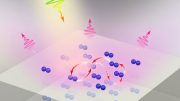
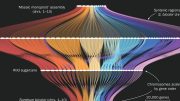

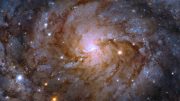
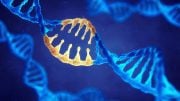

As I have stated many times before and will continue to repeat until it sinks in to all of those ‘THICK SKULLS OUT THERE! – ‘THERE ARE NO SUCH PHENOMENA AS, BLACK HOLES!’ The very concept not only goes against all of the rules of Science, it is a figment of some maniac’s imagination and something that belongs in Sci-Fi movies and Not in REALITY!
For anyone who is interested in learning the truth about the reason why the centre’s of spiral galaxies are so dense; it is because they contain the heaviest elements ever created at the core of our universe, – ‘BEFORE THE BANG’!
And, ‘Yes!’ I AM suggesting that our whole universe was in situ ‘BEFORE THE BANG!’ Wake up people and smell the sweet scent of, ‘TRUTH’! OUR UNIVERSE DID NOT COME FROM A SINGULARITY THE SIZE OF A PROTON! The latter is the most unscientific and inane proposal ever presented and anyone accepting such drivel as TRUTH needs to be CERTIFIED! In My view of course!